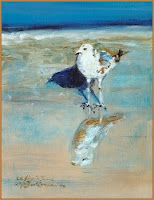


About Giclee Prints, Print History and these images
For the last ten years I have been working again in paint. During the previous 30 years I spent the better part of my Art Career as a Sculptor and building an Art Foundry. My early childhood training was in oils; the fundamentals of drawing and anatomy. I have always had a special interest in Maritime subjects and portraiture.
I have actively taught life drawing and portrait sculpture throughout my career. I have always been interested in introducing color to my sculptured bronzes in the form of polychrome patinas.
Print-wise I have produced a number of hand-cut serigraphs and I have a great respect for the process of various types of manual printing, such as etching and engravings as well as wood-cuts. These are all labor intensive and can be defined as their own art;- really they go far beyond the reproduction process of say a photo-lithograph, which is designed to faithfully reproduce a work of art without much deviation.
Print-wise I have produced a number of hand-cut serigraphs and I have a great respect for the process of various types of manual printing, such as etching and engravings as well as wood-cuts. These are all labor intensive and can be defined as their own art;- really they go far beyond the reproduction process of say a photo-lithograph, which is designed to faithfully reproduce a work of art without much deviation.
Recently, in the lexicon of art processes, comes the Giclee print. Which means to literally ‘spray’ the ink onto a page. Everyone who has printed with a computer is using that process. As the process has developed the images have become more and more vibrant and the overall print quality finer than or equal to the very best photo-lithograph.
The main difference for both the artist and consumer is lithographs are printed in bulk and Giclee’s can actually be printed one at a time. In both cases a high resolution photo of the artwork can be used for the original positive. With Giclee preparation process, artwork or photography, can be scanned to create a master file of the painting.
It might be interesting to note, in history, the print, in the form of the etching or stone lithograph was used to present a finished artwork, I.e. large painting, to a potential patron or purchaser of that art. This was introduced during the 12th and 13th century throughout cultured Europe.
Very often the Artist thought he had maybe a dozen potential sponsors for the Artwork and he would make a finished study of the Art to be created; -make a plate for an engraved print which could duplicate copies of the design to be sent on to as many clients who might purchase the Artwork, with a letter describing the project.
As time went on a great appreciation rose out of these prints and they were looked at as 'Art' in there own right. The 19th century artist, such as Toulouse-Latrec used the stone lithograph media to advertise Moulin Rouge and he would also number and sell the prints as did many of his contemporaries.
In the late 1800’s many very accurate etchings were hand colored for books and prints. By the mid 20th century the Off-Set press which with a 4-color photo-separation process and lightweight plates for printing really ramped up the possibility of large and consistent print runs. Enter the Giclee process about 10 or 15 years ago and now you have an even greater color and duplication control.
For me these images produced in print and on these pages are highly autobiographical. They follow friends I’ve met and places I have been to. In every case I knew the subject or individual;- lived near or around the location that I painted.
Bill Osmundsen
Greenwich Village,
NYC, NY
Greenwich Village,
NYC, NY
PS: To purchase or learn more about these prints:- Click here !

